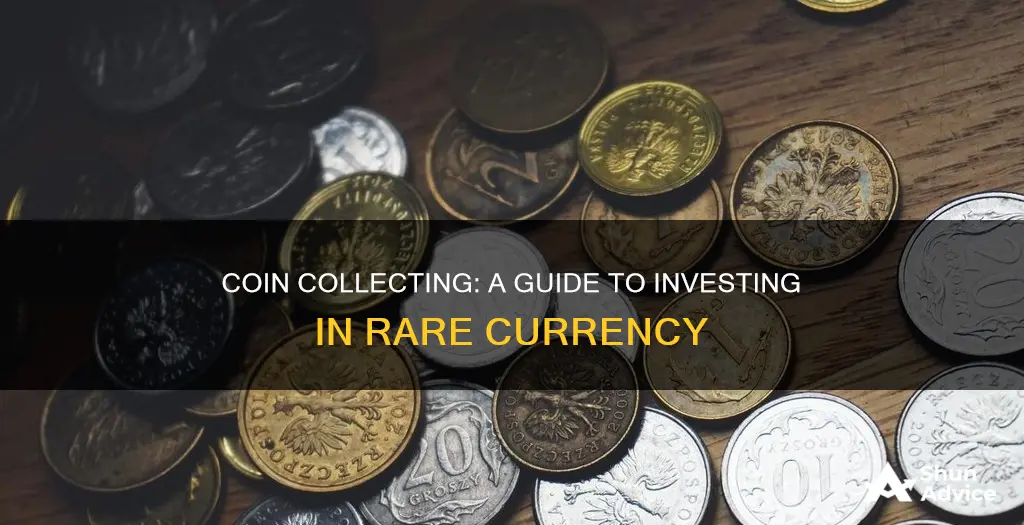
Coin collecting is a fun hobby for many, but it can also be a profitable investment strategy. Coins are considered a commodity-like investment, with the potential for attractive financial returns. The value of a coin is derived from two main sources: the physical metal it contains (known as its bullion value) and its collector or numismatic value. The bullion value is based on the amount of precious metal in the coin, such as gold or silver, while the numismatic value depends on factors like rarity, condition, and buyer sentiment.
Investing in coins can be a way to diversify your portfolio and reduce risk, especially during times of economic uncertainty. Coins are also a hedge against inflation, as their value tends to increase over time. However, it's important to note that investing in rare coins may not be ideal for short-term profits, as the market can fluctuate, and it may take time to realize gains.
For beginners, it's recommended to find a mentor or connect with experienced collectors, study up on coin values and rarity, and focus on a specific area of interest, such as a particular time period or denomination.
| Characteristics | Values |
|---|---|
| Inflation Protection | The value of physical coins can increase or at least keep up with the pace of inflation. |
| Intrinsic Value | Gold and silver have intrinsic value because they are raw materials that can be converted into other goods. |
| Portfolio Diversification | Coins are uncorrelated to the performance of traditional investments like stocks and bonds. |
| Store of Value | Coins can hold their value and even increase in value over the long run. |
| Collectability | Numismatic coins are bought and sold for their rarity, metal purity, and historical value. |
| Liquidity | The bullion market is larger and more liquid than the numismatic market. |
| Investment Horizon | Rare coins have an investment horizon of a few months to many years. |
| Risk | The rare coin market can be volatile and is subject to fluctuations in precious metal prices. |
| Profitability | Rare coins can be profitable but are not ideal for short-term gains. |
| Bullion Value | The bullion value of a coin is determined by the amount of precious metal it contains and the spot price of that metal. |
| Numismatic Value | The numismatic value of a coin depends on its rarity, condition, and collector demand. |
| Grading | Grading standards may vary, but well-known auction houses and coin grading services can be used as a reference. |
| Fraud | Beginners should be aware of the potential for counterfeit or doctored coins. |
What You'll Learn

Bullion vs Numismatic Coins
Bullion and numismatic coins differ in their purpose, value, and the reasons why people buy them. Bullion coins are acquired for their precious metal content, whereas numismatic coins are often sought for their rarity.
Bullion coins are minted using highly refined precious metals such as silver, gold, platinum, and palladium. Their value is based on their weight and fineness, or purity. The standard varies by metal—for example, silver bullion must have a millesimal fineness of 999, or 99.9% purity. Gold bullion has the same standard, which is also known as 24-karat gold. Platinum and palladium bullion must meet a minimum requirement of 99.95% purity.
Bullion coins are often available at a lower price than numismatic coins. They are a good option for those who want to invest in precious metals without worrying about trends or fashion. Gold and silver, in particular, have been valued by humans for thousands of years and are likely to continue to be valued.
On the other hand, numismatic coins are often older and crafted for collecting. They are typically more expensive than bullion coins due to their rarity and the effort that goes into creating them. Numismatic coins are usually struck multiple times to ensure a clear and crisp design. They often have a proof quality finish, with a mirror-like background and delicately frosted raised design elements.
While the value of bullion coins is based solely on their metal content, the value of numismatic coins depends on additional factors such as rarity, historical context, condition, and demand. The fewer examples of a coin that were minted, the higher its collector value is likely to be. Numismatic coins also tend to be older, making them appealing to those interested in the historical aspect of coin collecting.
When deciding between bullion and numismatic coins, it's important to consider your goals. If you want a cost-effective way to invest in precious metals, bullion coins are a good choice. If you're more interested in the hobby of collecting and the historical significance of coins, then numismatic coins may be a better option. However, keep in mind that numismatic coins typically carry larger risks and have higher premiums.
Best POS Coins: Where to Invest Now?
You may want to see also

Rare Coins as a Long-Term Investment
Rare-coin investing can be a profitable long-term investment strategy. The more rare a coin is, the more valuable it becomes. Rare coins can also add diversity to a portfolio that is focused on stocks and bonds.
However, investing in rare coins is not ideal for short-term profits. The rare-coin market can fluctuate like the stock market as demand for a particular coin increases and wanes.
Historically, rare coins have offered significant profit potential above and beyond the underlying metal value of a coin. Prices of elite coins appreciated more than 1,000% from 1976 to 1980 and 600% from 1982 to 1989, according to Finest Known, a rare-coin newsletter.
Investing in rare coins is no substitute for traditional investments to reach your financial goals. However, this asset class can help you diversify your portfolio and reduce risk.
The rare-coin market has changed significantly over the past few decades. Grading coins, or verifying their authenticity and defining standards, was opened to third-party grading services in the 1980s, which helped remove some of the risks of investment. The internet also brought the opportunity to access more knowledge online about coin collecting, rare coins, and buying coins.
If you’re just getting started investing in rare coins, consider connecting with a mentor who can guide you through researching the value and potential future value of coins. You can also learn about this field by collecting through coin shows, reading books and articles, talking to coin dealers, and joining coin clubs.
Just as with any investment, a balanced coin portfolio reduces your risk of market fluctuations and provides greater potential for returns. Having a variety of U.S. coins, precious metals like gold bullion coins, and classic gold coins like the double eagle can improve your portfolio’s diversity.
Rare-coin collecting is not ideal for making short-term gains. Coin flipping is a strategy that aims for short-term gains with coins, but it can be risky. With this strategy, you buy a low-mintage coin directly from the mint and then try to quickly sell it for a larger profit. You could lose money if you miss the opportunity to sell quickly or the market becomes flooded.
The rare-coin market isn’t free from market fluctuation. In fact, it can even be volatile at times. Coin prices depend on supply and demand. If a demand for a particular coin or series of coins gains in popularity, the price can soar—only to crash later if the coin’s popularity decreases.
One difference between investing in rare coins and shares of a company is that coins are not alike, while a share of a particular company is worth the same as another share. For example, two 1913 Buffalo nickels may not be the exact same price even if the coins have identical variations and the same grading. They may be valued differently because of subtle differences in the coin, such as one looking slightly better than the other. Investing in rare coins is more unpredictable in that way.
The best way to start investing in rare coins is to find a mentor who can guide you through how to determine the value of rare coins. You can also read books and articles on the topic, attend coin shows, or join coin clubs. Familiarize yourself with how coins are valued so that you can better predict potential returns.
Tips for Investing in Rare Coins
- Diversify your portfolio: As with any investment, diversification is key to reducing risk. Include a variety of coins in your portfolio, such as classic U.S. coins like half cents and large cents, as well as precious metals like gold bullion coins.
- Take a long-term approach: Rare-coin collecting is typically not ideal for short-term gains. Successful investors in coins usually have a long-term vision that takes years, if not decades, to assemble a valuable collection.
- Acquire knowledge: Educate yourself about the coins you are purchasing and the market valuation of each coin. This will enable you to spot coins of truly exceptional value.
- Buy high-quality certified coins: Only buy coins that are certified by reputable coin grading services such as the Professional Coin Grading Service (PCGS) or Numismatic Guaranty Co. (NGC).
- Beware of counterfeit and doctored coins: Be cautious of counterfeit or doctored coins, which are altered to conceal defects and misrepresent their condition and value. Experts can usually detect these alterations, but beginners may be fooled.
FunFair Coin: A Good Investment Option?
You may want to see also

How to Store Your Coins
Properly storing your coins is essential to retaining their value and condition. Coins are vulnerable to scratches, dents, tarnishing, and discoloration, so investing in appropriate storage materials is crucial. Here are some detailed instructions on how to store your coins:
- Choose the Right Storage Materials: Opt for hard plastic coin holders, coin capsules, or cardboard 2x2 holders. Hard plastic holders offer the best protection against physical damage, while coin capsules provide airtight protection for individual coins. Cardboard holders are a cost-effective option but may not be suitable for high-quality coins.
- Prevent Tarnish and Discoloration: Store your coins in airtight containers or holders to prevent tarnishing and discoloration due to air and moisture exposure. Coin tubes or storage boxes with tight-fitting lids create a sealed environment, especially for silver or copper coins prone to oxidation.
- Use Acid-Free and PVC-Free Materials: Acid and PVC can damage coin surfaces, causing staining or deterioration. Choose archival-quality, acid-free albums and pages, or coin sleeves, to prevent chemical reactions and preserve your coins.
- Organize and Categorize: Create a systematic organization system to easily locate and track your coins. You can categorize them by country, year, denomination, or theme. Use dividers, trays, and clear labels for easy identification. Keep a detailed catalogue or inventory of your collection, including coin details, condition, and acquisition date.
- Handle with Care: Always handle coins with clean hands or wear soft cotton gloves to prevent transferring oils and dirt. Avoid touching the coin surfaces and hold them by their edges or rims. Use a clean, soft cloth specifically designed for numismatic purposes to remove surface dirt or smudges, avoiding abrasive materials and harsh chemicals.
- Store Valuable and Rare Coins: Use individual coin holders or capsules to protect valuable and rare coins from environmental factors and physical damage. Choose holders made from inert materials like plastic or Mylar. Store each coin separately, especially those made from softer metals like gold or silver. Ensure the storage materials are acid-free and PVC-free, labelled as archival quality.
- Temperature and Humidity Control: Maintain a controlled environment with stable temperature and humidity levels. Aim for a temperature of around 68 degrees Fahrenheit and relative humidity of 50%. Avoid extreme temperature changes and direct sunlight, as this can cause tarnishing and corrosion.
- Safe Storage Options: Consider storing valuable coins in a bank's safe deposit box or a home safe to protect against theft, fire, and other unforeseen events. Ensure your home insurance covers full replacement costs for your collection.
- Regular Inspection and Maintenance: Periodically inspect your stored coins to check for any signs of damage, such as toning, spots, or corrosion. Handle them gently with clean hands or gloves to avoid transferring oils and dirt. Re-house or clean the coins if necessary, and update your inventory records accordingly.
- Physical Storage Options: You can store your coins in coin tubes, cardboard flips, albums, or plastic holders. Cardboard flips are inexpensive and convenient, but be cautious when removing staples to avoid scratching the coins. Albums allow you to display both sides of the coins, while plastic holders provide individual protection. For the most expensive option, send your coins to a third-party grading company for encapsulation and grading, then store them in boxes or wooden presentation holders.
Little Money, Big Risk: Is Bitcoin Worth the Gamble?
You may want to see also

Coin Grading
The most widely accepted grading scale is the Sheldon grading scale, ranging from 1 to 70, with higher numbers indicating better-graded coins. This scale was first introduced by renowned numismatist Dr. William Sheldon in 1948 and has since become the industry standard. The Professional Coin Grading Service (PCGS) and the Numismatic Guaranty Company (NGC) are two well-known companies that use this scale.
The grading process involves a detailed examination of a coin's surface, taking into account any imperfections, wear and tear, or alterations. Grading services may use magnification to assess the coin's condition accurately. The assigned grade significantly influences a coin's value, especially for rare or antique coins.
Coins are also categorised based on their method of production and overall appearance. The most common categories are Mint State (MS), Proof (PF), and Specimen (SP). Mint State coins are struck for circulation and typically receive grades of 60 to 70. Proof coins, on the other hand, are struck for collectors and often have a unique format. Specimen coins fall somewhere between Mint State and Proof, exhibiting some characteristics of both.
In addition to the numeric grade, grading services may use two-letter codes to indicate a coin's production method and appearance. For example, the MS code signifies a Mint State coin, while PF denotes a Proof coin. These codes provide additional context to the assigned numeric grade.
It is important to note that grading standards may vary among different grading services and auction houses. However, reputable companies like PCGS and NGC have played a crucial role in standardising the process and providing investors with peace of mind. Their expertise and use of secure encapsulation methods ensure the authenticity and protection of valuable coins.
When investing in rare coins, it is recommended to familiarise yourself with the grading process, research trusted grading services, and only purchase coins that have been certified by reputable companies. This due diligence can help minimise the risks associated with counterfeits and maximise the potential for profitable investments in numismatics.
How Indians Can Invest in Bitcoin
You may want to see also

Coin Flipping
The rare coin market can be volatile, with coin prices fluctuating depending on supply and demand. If a particular coin or series gains popularity, its price can soar, only to crash if its popularity wanes. This is similar to how the stock market operates, with a myriad of factors influencing the market.
When investing in rare coins, it's important to have a balanced portfolio to reduce the risk of market fluctuations. This includes a variety of US coins, precious metals like gold bullion coins, and classic gold coins like the double eagle.
To get started, find a mentor who can guide you in researching the value and potential future value of coins. You can also read books and articles, attend coin shows, or join coin clubs. It's crucial to familiarize yourself with how coins are valued so you can predict potential returns.
Additionally, be aware of the potential for counterfeit or doctored coins. Only buy from reputable coin dealers and purchase coins that are certified by professional coin grading services.
Alpha Coin: Worthy Investment or Risky Business?
You may want to see also
Frequently asked questions
Coins can be a great way to diversify your portfolio and reduce risk. They can also protect against inflation and are a tangible asset that will provide diversity in a portfolio and hedge against inflation.
Earning money from investing in rare coins takes time. The market can be volatile and, unlike stocks, there is no guarantee of how a coin will change in value.
Bullion coins are those bought and sold for their metal content, usually gold or silver. Numismatics are coins that are valued for their rarity, historical value, and collector demand.
It's important to do your research. Find a mentor, read books and articles, attend coin shows, and join coin clubs. You can also buy from dealers or individual sellers, either in person or online.







